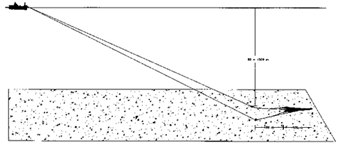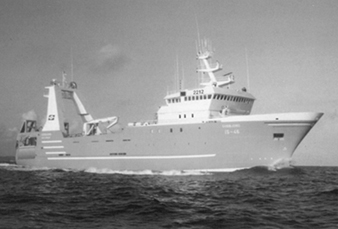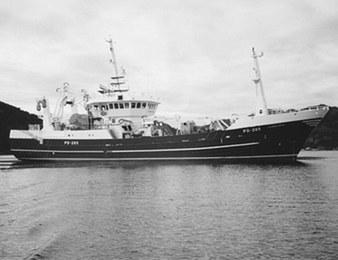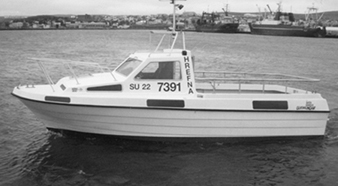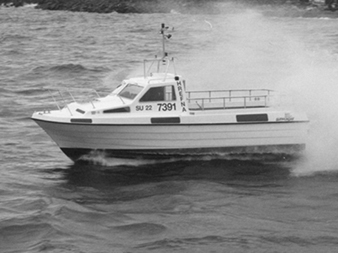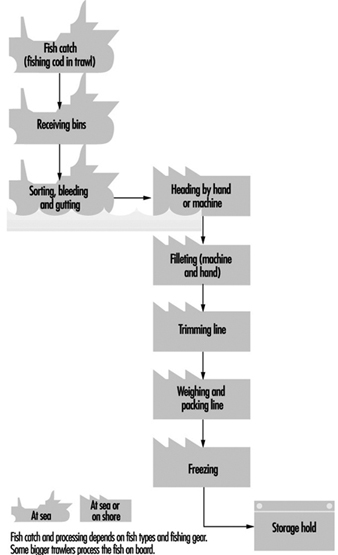Characteristics of Work at Sea
Work at sea aboard fishing vessels is in several ways different from work aboard general cargo vessels, although the activity connected to navigation is similar or the same. The principal difference between a general cargo ship and a fishing vessel is that cargo vessels load their cargo in harbours. After loading, their hatches must be closed watertight and are not normally opened until arrival at the next harbour, where the cargo is to be unloaded.
Fishing vessels, on the other hand, catch fish at fishing grounds and thus take on board their “cargo” at sea. Therefore, a fishing vessel more or less frequently has to operate with some of the hatches open at sea, which can involve a danger of flooding.
Another factor is the catching operation itself. Often there is a heavy drag from fishing gear, even on small vessels. Furthermore, fishing operations often take place at open and unsheltered fishing grounds. In addition, the crew on many smaller fishing vessels still has to work without shelter on open decks.
Fishing vessels are therefore more vulnerable than cargo ships, especially in heavy seas, and require a very different approach at the design stage, as well as guidelines for the education and training of skippers and crew.
Fishing Methods and Types of Fishing Vessels
The types of fishing vessels are generally governed by the fishing methods to be used. Some fishing vessels are designed just for one fishing method, but others are multi-purpose vessels, which are able to use two or more different types of fishing gear. The principal methods in operation from fishing vessels are the following:
- bottom trawling
- mid-water trawling
- purse seining (encircling gear)
- long-lining
- drift gill nets
- linefishing on small boats.
Bottom trawling
Side trawling was the original method of bottom trawling. A side trawler has two gallows, one forward and one aft, usually on the starboard side (the right side of the vessel when looking forward). The trawl net is set over the side by the crew and the warps (wire ropes) passed over blocks hanging from the gallows. Trawl doors (otter boards), one on each side of the mouth of the net, are set at an angle to keep the net open when pulled by the vessel along the bottom (see figure 1). The fish are gathered in the so-called cod end of the net. The superstructure of a side trawler is aft of amidship, with a double-drum trawl winch usually in front of it on the foredeck. The catch is lifted aboard on the foredeck end by a derrick on the forward mast. Very few side trawlers are still in use, as almost all have been replaced by stern trawlers. The stern trawlers have the bridge forward and a large gantry side to side aft instead of the gallows (see figure 2). The bigger stern trawlers have a shelterdeck; the main trawl winch is often amidship; and usually there are several smaller winches on the afterdeck for lifting parts of the fishing gear. The trawl net is pulled up a stern ramp on top of the shelterdeck, where the cod end is lifted, and the contents emptied through a hatch into pounds on the main deck below, which is a factory deck on big stern trawlers.
Figure 1. Stern trawler bottom trawling.
Skipataekni Ltd.
Mid-water trawling
The purpose of mid-water trawls is to catch pelagic and other species of fish in schools at various levels between the bottom of the sea and the surface. Mid-water trawling is operated by same type of ships as bottom trawling, but vessels are usually fitted with a large net drum for the much bigger nets. There are special mid-water trawl doors, weights and floats on the warps to regulate the depth of the trawl below the surface.
Purse seining (encircling gear)
The purpose of purse seiners is to catch free-swimming species of schooling fish, like herring, capelin and mackerel. Catches can be very large, and high carrying capacity of the vessel can therefore be of importance. The seining net has floats on top and weights on the bottom. As the vessel has to lay out the net in a ring around the school of fish, good manoeuvrability and especially good turning ability are important. There are two types of purse seiners. One of them has been called the American type and the other, the North European (or Nordic) type. Both use hydraulically driven power blocks. The American vessels have the bridge and accommodation forward, with the power block on a derrick from the mast abaft the deckhouse. The Nordic purse seiners were originally of the side-trawler type, with deckhouse, wheelhouse and accommodation aft. The powerblock is usually located on the starboard side of the wheelhouse; a hydraulically driven transport roller carries the net from the power block to the net bin at the stern. After enclosing the school of fish, the purse-seine net is closed at the bottom by the pursing winch on the deck pulling the bottom warp; the fish are then pumped from the purse seine through a fish/water separator into the hold.
Newly designed and built Nordic purse seiners (see figure 3) are now commonly of the same size as the big stern trawlers, with a tweendeck from fore to aft and a separate net bin aft. The arrangement of the powerblock is still similar to the original type of vessels.
Figure 3. Purse seiner.
Skipataekni Ltd.
Long-lining
Long-lining is a fishing method where a long line is set out, to which several short lengths of line with a baited hook on the end are connected with a separation of 1 to 2 m. After some time, the fishing vessel hauls in the long line and the caught fish are removed from the hooks. This fishing method has for a long time been and still is used on rather small fishing vessels without shelter on the open deck (see figure 4 and figure 5). Usually the hooks are baited on land and coiled in tubs. The fishing vessel runs the long line out over the stern and hauls it in from the starboard side with a hydraulic line hauler.
Figure 4. Small linefishing high-speed boat (stationary).
Batasmidja Gudmundar
Figure 5. Small linefishing high-speed boat (running).
Batasmidja Gudmundar
A modern linefishing vessel, equipped for long-lining with autoline, has a shelterdeck, with a side-opening for the hauling and an opening at the stem to set the long line out. Both openings can be closed weathertight, and are bulkheaded off so that only a limited part of the working deck can be flooded, in case of a breaking wave. After the line has been hauled into the vessel through the line hauler, it goes through an automatic baiting machine where old bait is cleaned from the hooks and the new bait is hooked on in one operation, just before the line is run out again. Long-lining vessels can be about 60 m in length with accommodation for around 20 to 40 crew members. The autoline system has up to 40,000 to 50,000 hooks on a longline up to 60 km in length. The line is run out at a speed of 7 to 8 knots, and the line hauler has a pulling power of about 5 t. The fish process space is in the tweendeck, which is fitted with belt conveyors, bins and tables for manual gutting and filleting. In some cases these vessels are equipped for freezing the fish.
Drift gill nets
Gill nets trap fish by entangling their gills. On fishing vessels with superstructure aft and open working deck amidship, several drift gill nets are set end to end over the side. A dan buoy is secured to the free end of the nets, and a number of floats are connected to the top line along the nets. The fishing vessel keeps the nets stretched. This drift net fishing has now in many countries been replaced by purse seiners and mid-water trawlers.
Linefishing on small boats
Coastal fishing on small boats is still an important activity in many countries and has now developed considerably. Small open wooden boats with outboard or inboard motors have largely been replaced by decked or half-decked boats, mostly built of fibreglass and designed as high-speed boats which can reach midshore fishing grounds. The length of these boats is usually from 8 to 15 m. With engines of 250 to 400 horsepower they can reach a cruising speed up to 24 knots. The cabin usually has two berths, a galley and a WC. Several of these boats are fitted with up to four jigging reels, which are computerized automatic linefishing machines. The jigging reel pays out the line and detects when the sinker hits the bottom, positions the hooks at a desired distance from it and performs jigging actions. It detects when a fish bites the hooks and then hauls the catch up to the surface.
Fish Processing on Board and on Shore
With the increasing size of fishing vessels, and also the more extensive deep-sea fishing far away from home ports, fish processing on board fishing vessels has also increased considerably. As space on board is more limited than at processing plants on shore, there has been a need for more compact arrangements and new development of processing lines with automatic fish-processing equipment both for fish and shrimp.
Forward of the upper edge of the stern ramp slipway of a modern stern trawler, the content of the cod end of the trawl is emptied through hydraulically operated hatches from trawl deck down to the stainless steel bins on the receiving deck below, which is abaft of the fish-processing area. Through four hydraulically operated hatches in the front bulkhead of the receiving bins, the fish-processing line receives the fish and carries it between the working stations in the fish-processing area, which is 520 m2. The processing is arranged for production of fillets, blocks, mince and headed and gutted fish. See figure 6 for an illustration of the process.
Figure 6. Flow chart of fishing and processing
The processing line is arranged as much as possible for automatic processing with conveyors, buffer stores, by-pass functions and so on. The layout includes the following items:
- sorting and bleeding conveyor
- one heading and gutting machine
- ten buffer tanks with icewater cooling
- two conveyors for transporting fish from buffer tanks to production
- conveyor for bringing fillets from two filleting machines to trimming
- trimming line with eight working stations
- packing line with automatic weighing station (auto-portioning) and five packing stations.
The processing line is also arranged with a hand fillet station with four positions. The freezing system is connected to three horizontal automatic plate freezers and one manually operated freezer. The capacity for freezing is approximately 70 tonnes of fish fillets per 24 hours.
The carton size used is of fixed standard, and the fillets and block are packed into a standard weight of frozen block. A cargo elevator is installed for transporting from the processing line to the hold. The fish hold, with a total volume of 925 m3, can be kept at –30°C, with an outside temperature of 30°C and a seawater temperature of 20°C.
In the starboard side of the fish processing area there is a separate shrimp-processing line with sorting conveyor, shrimp grading machine, shrimp cooker, shrimp weighing, freezing tunnel and packing. A part of the fish-processing equipment for whitefish is also utilized for the shrimp processing (e.g., receiving bins, plate freezers, packing, transport conveyors and storage in the fish hold).
A fishmeal factory, with 50 to 60 tonnes capacity of raw material and producing 7 to 9 tonnes of fishmeal in 24 hours, is installed in some bigger freezer trawlers. For good quality, such a factory relies on steam heating of the dryer, with steam from a combined exhaust/oil boiler. Such a fishmeal factory consists of the following machines:
- an indirect cooker with steam-heated jacket and rotor, and nozzles for steam supply direct to the fish
- a strainer conveyor and a twin-screw press
- a tearing conveyor to transport the presscake to a steam-heated rotadisc drier
- a pump to transport the presswater overboard
- a suction pipe to transport the meal from the receiver under the drier outlet to the milling plant.
Ducts then lead from the milling to a bagging station in the fishmeal hold, where the fishmeal is packed into 35 kg paper or jute bags and stored.
For the crew working in the processing area there are adjustable platforms at stations where persons stand for long periods of time.
The fish-processing equipment for whitefish and other seafood on board factory vessels which are not engaged in fishing operations is almost the same as in fishing vessels, like stern trawlers, which are processing their own catch. The main difference is that such factory vessels follow the fishing fleet to the fishing banks and receive their catch for processing and transport to port.
The development of the freezing lines and fish-processing equipment for ships has also had great influence on the equipment in fish-processing factories on land. The automatic but flexible system is built with a number of workstations where product quality, performance, capacity and yield are monitored individually for optional management of the system. Fillets are sent to a portioning machine, and the portions are then sent for individual quick freezing or to packaging stations. Due to the conveyor system of the processing lines for both fish and shrimp, the lines offer remarkable throughput with minimum effort, without the workers ever having to lift or throw the fish.
International Codes
Three United Nations organizations—the FAO, the International Labour Organization (ILO) and the International Maritime Organization (IMO)—entered into an agreement to cooperate in a project to draw up a code of safety for fishers and fishing vessels, each working within its respective field of competence:
- FAO—fisheries in general
- ILO—labour in the fishing industry
- IMO—safety of life, vessels and equipment at sea.
A joint group of consultants from the three organizations drew up the Code of Safety for Fishermen and Fishing Vessels in two parts: Part A, safety and health practice for skippers and crews, containing operational and occupational requirements; and Part B, safety and health requirements for the construction and equipment of fishing vessels. The purpose of this guide is to reduce the risk of injury to fishermen and as far as possible prevent accidents, as well as lessen the risk of danger to the vessel. The IMO coordinated proposed amendments, but any amendments were subject to the final approval of the three organizations. Revised editions of the Code have been published by IMO on behalf of the FAO, the ILO and the IMO.
Part A contains basic information necessary for the safe conduct of fishing operations, such as safety of navigation, seaworthiness of the vessel and proper equipment. Other precautionary measures to be taken include maintaining adequate stability of the vessel; precautions against falling overboard; general safety on deck; safety in machinery spaces and of mechanical equipment; and knowledge of life-saving appliances, fire prevention and precautions and first-aid equipment. The continuous maintenance of all safety devices of the vessel and its equipment is also essential.
For the safety of a fishing vessel, the operation and handling of the ship is a basic factor. Skippers of fishing vessels 24 m in length and over, operating in unlimited waters, must be knowledgeable about all aspects of navigation, fishing vessel manoeuvring and handling, construction and stability. The skipper must be able to use stability data and evaluate the influence of the fish load, of the amount of water and oil in tanks, of water trapped on deck, of closure of openings in the ship and of the pulling of fishing gear.
For the safety of fishing vessels and their crew, it is essential that the education, training and certification for all persons serving on board seagoing fishing vessels is of recognized high standards. To achieve this, an International Convention on Standards of Training, Certification and Watchkeeping for Fishing Vessel Personnel, 1995, was signed at the IMO headquarters in London. Those States for which this Convention has entered into force have undertaken to promulgate all laws, decrees, orders and regulations so as to ensure that, from the point of view of safety of life and property at sea and the protection of the marine environment, seagoing fishing vessel personnel are qualified and fit for their duties. This Convention shall enter into force 12 months after the date on which not less than 15 states have ratified it.
The regulations annexed to the Convention cover mandatory minimum requirements for certification of skippers, officers, engineer officers and radio operators, as well as specified basic safety training for all fishing vessel personnel, and regulations on basic principles to be observed in keeping a navigational watch on board fishing vessels.
Among the items for examination of candidates for certification as skippers and navigational officers on fishing vessels in unlimited waters are the following: navigation, watchkeeping, electronic position-fixing, meteorology, communications, fire prevention, life saving, fishing vessel manoeuvring and handling, fishing vessel construction and stability (including knowledge of effects of free surfaces and ice accretion), catch handling and stowage, English language, medical aid, maritime law, search and rescue, knowledge of the FAO/ILO/IMO Code of Safety for Fishermen and Fishing Vessels, Part A, and prevention of marine pollution.
Crew Accommodation and Equipment for Crew in High-Seas Fishing Vessels
In the bigger types of freezer stern trawlers, intended for fishing in high seas, often staying for months far away from home port, the accommodation and equipment for the crew is usually extensive. For example, a new 68 m long Icelandic stern trawler delivered in 1994 has accommodation for 37 persons. There are 13 one-person cabins and 12 two-person cabins, as well as a hospital cabin with 2 berths and separate toilet and washing basin. The total accommodation area is 625 m2. All the cabins have access to separate toilet, washing basin and shower. Besides messroom and galley, there are two TV saloons, one sauna and one trim room. Entertainment equipment includes two 28-inch stereo colour TVs, two video tape recorders, a stereo and receivers. There are radios for each cabin and ten for the process deck. On deck there are a common toilet, wardrobes for the deck crew with lockers, wash basins and wash machines/dryers, and an oil-skin room with high boots dryer and so on.
Fishing Locations
Fishing locations in the world are very different, as are the types and sizes of fishing vessels in use. The most simple dug-out canoe on an inland lake and a sophisticated and well equipped factory trawler in the high seas both have the same purpose—to catch fish.
From the safety point of view, fishing sea areas in Part B of the Code are divided into three categories:
- unlimited sea areas
- sea areas up to 200 nautical miles from a place of shelter
- sea areas up to 50 nautical miles from a place of shelter.
Fishing locations or fishing banks are, however, more commonly divided into coastal fisheries and high-sea fisheries.
Coastal fisheries are located in coastal waters, but the distance from the shore can vary, depending on local conditions. In fjords or other sheltered waters, small (even open or half-decked) motorboats are used for 1 day fishing trips; for longer trips, small-decked motorboats of very different local types are used.
High-sea fisheries are fishing operations farther from the coast, and the outer limits from the shore are not fixed. Fishing vessels intended for high-sea fisheries are usually designed for unlimited sea areas, since in many coastal countries the high sea (or ocean) is located just outside the sheltered fjords or coastal skerries.
Fishing Vessels
As described above, fishing vessels used for fishing in the high seas are of very variable types and sizes—stern trawlers (fresh-fish vessels with processing lines), purse seiners, long-liners, factory ships and so on. The international definition of a fishing vessel is a vessel used commercially for catching fish, whales, seals, walruses or other living resources of the sea. A processing vessel is a vessel used exclusively for processing the catch.
The features of fishing vessels are so different from other seagoing ships that they could not be covered individually by the international conventions for safety of life at sea. An International Convention for the Safety of Fishing Vessels was drawn up at the International Conference on Safety of Fishing Vessels held in 1977 in Torremolinos, Spain. This Convention is based on the technical work at IMO over several years, mainly in the Maritime Safety Committee’s Subcommittee on Safety of Fishing Vessels. This Committee had previously prepared recommendations on the intact stability of fishing vessels, published by IMO and later included in the 1977 Convention for the Safety of Fishing Vessels. That Convention stated that it shall apply only to new fishing vessels 24 m in length and over. Smaller fishing vessels are not covered by this important safety Convention because the types of smaller vessels of nations’ fishing fleets are very different, and very limited technical information is available. Therefore it was merely due to lack of basic information that safety regulations for these fishing vessels could not be worked out. Even for fishing vessels in the lower ranges above 24 m in length, there is a great difference in hull form and fishing methods. All such features have considerable influence on stability and seaworthiness generally.
The technical information on which the regulations in the Convention are based was supplied mostly by industrialized fishing countries in Europe and North America. Soon after the 1977 conference, it became evident that several countries elsewhere in the world envisaged difficulties in ratifying parts of the Convention for the smallest fishing vessels in their fleet above 24 m in length. A 1993 conference held in Torremolinos resulted in the Torremolinos Protocol of 1993, which relaxed certain items of some of the chapters in the Convention for certain fishing vessels. The chapter on machinery and electrical installations and periodically unattended machinery spaces is, following the Protocol of 1993, applicable only to new vessels 45 m in length and over. The chapter on fire protection, fire detection, fire extinction and fire-fighting was subdivided into two parts: Part A is applicable to new fishing vessels 60 m in length and above, and Part B contains less stringent requirements for vessels between 45 and 60 m. The chapter on radio communications applies to both new and existing vessels 45 m in length and over. The Protocol of 1993 to the 1977 Torremolinos Convention also updates the parent Convention and takes into account technological evolution in the years between 1977 and 1993. The Protocol was extended to include those vessels processing their catch.
The 1977 Torremolinos conference adopted a recommendation concerning the development of safety standards for decked fishing vessels less than 24 m in length, since it was noted that the vast majority of fishing vessels throughout the world are less than 24 m in length. It was recommended that the IMO continue to develop safety standards for design, construction and equipment of such fishing vessels with a view to promoting the safety of those vessels and their crews. Such guidelines have been developed by the IMO in cooperation with the FAO and the ILO.
The Safety of Fishing Vessels
Construction
The safety of ships, including fishing vessels, depends on the construction and strength of the ship itself being sufficient for its intended use. Thus strength and construction of hulls and superstructures must be sufficient to withstand all foreseeable conditions of the intended service. The watertight integrity of the vessel has to be ensured, and all openings through which water can enter have to be provided with suitable closing devices, including deck or side openings which may be open during fishing operations.
Freeing ports are very important for the safety of fishing vessels. They allow water to run off from where bulwarks on weather parts of the working deck form wells that can trap water. On small fishing vessels, the height of such bulwarks has been increased so as to better protect the crew working on open deck. The weight of water on deck can be considerable and can be a great danger to stability if the deck area is not rapidly freed of water. Therefore, a minimum freeing port area to ensure that the deck is rapidly and effectively freed of water is essential.
In more recent designs of even small and medium-sized fishing vessels, the working deck has been covered with a shelterdeck. If the tweendeck of such vessels can be kept completely closed during most fishing operations, or if a watertight opening in the tweendeck is in a small watertight compartment, it is reasonable to accept high-capacity bilge pumps, instead of freeing ports, to empty water from the working deck. This design has increased considerably the form-stability of fishing vessels, by using a much higher freeboard.
Fishing Vessels’ Stability and Seaworthiness
Besides strength and watertightness, stability and general seaworthiness are the most important factors in safety of a fishing vessel.
Member countries supplied the IMO Subcommittee on Safety of Fishing Vessels with valuable material on stability calculations for existing vessels with proven records of successful operations, and actual loading conditions of fishing vessels which capsized or suffered large and dangerous heeling. Criteria of minimum stability were developed from this material.
Calculations can be made for static stability, but the movements of a ship in a seaway are governed by dynamic forces which are very difficult, if not impossible, to calculate, since the wind and sea conditions are so irregular. On the other hand, a fishing vessel which has been used without an accident for, say, 15 or 20 years for fishing operations in all normal weather and sea conditions can be considered reasonably safe. The use of so-called weather criteria, where wind and wave action and the effect of water trapped on deck are taken into account in stability considerations, are also recommended. All these calculations and other suitable stability information must be supplied to the skipper, who must assess the stability of the vessel under various operating conditions.
As mentioned before, stability is influenced by the freeboard of the vessel. The stipulation of load lines for fishing vessels was considered by the Fishing Vessel Conference in 1977, as the International Load Line Convention applies only to cargo ships. It was concluded that it was impractical to observe load line marks at fishing grounds when loading. However, the Torremolinos Convention for Safety of Fishing Vessels requires that a maximum permissible operating draught must be approved by the administration in each country and be such that the stability criteria are satisfied.

